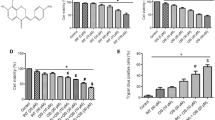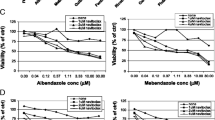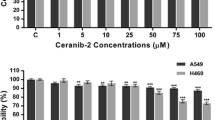Abstract
Background
The antitumor peptide CIGB-552 is a new targeted anticancer therapy which molecular mechanism is associated with the inhibition of the transcription factor NF-kB, mediated by COMMD1 protein stabilization. In this study, we examined the antiproliferative capacity of CIGB-552 in combination with chemotherapeutic agents in lung cancer models.
Methods and results
We combined of CIGB-552 and the antineoplastic agent Cisplatin (CDDP) in concomitant and pre-treatment scenary in a dose matrix approach. This study was performed in the non-small cell lung cancer cell lines NCI-H460, A549 and in a mouse model of TC-1 lung cancer. Our results demonstrate a clear synergic effect between 37.5 μM of CIGB-552 and 5 μM of CDDP under concomitant scheme, on proliferation inhibition, cell cycle arrest, apoptosis induction and oxidative stress response. The effect of CIGB-552 (1 mg/kg) and CDDP (0.4 mg/kg) administrated as a combined therapy was demonstrated in vivo in a TC-1 mouse model where the combination achieved an effective antitumor response, without any deterioration signs or side effects.
Conclusions
These findings demonstrate the efficacy of the concomitant combination of both drugs in preclinical studies and support the use of this therapy in clinical trials. This study is the first evidence of synergistic effect of the combination of the antitumoral peptide CIGB-552 and CDDP.





Similar content being viewed by others
Data availability
We declare total transparency with the data generated and presented in the above manuscript.
Code availability
Not applicable.
References
Hanahan D, Weinberg RA (2011) Hallmarks of cancer: the next generation. Cell 144(5):646–674
Bray F, Ferlay J, Soerjomataram I, Siegel RL, Torre LA, Jemal A (2020) Erratum: global cancer statistics 2018: GLOBOCAN estimates of incidence and mortality worldwide for 36 cancers in 185 countries. CA Cancer J Clin 70(4):313
Bray F, Ferlay J, Soerjomataram I, Siegel RL, Torre LA, Jemal A (2018) Global cancer statistics 2018: GLOBOCAN estimates of incidence and mortality worldwide for 36 cancers in 185 countries. CA Cancer J Clin 68(6):394–424
(2020) Anuario Estadístico De Salud. Minsap, Cuba. Dirección Nacional De Registros Médicos Y Estadísticas De Salud, Havana, Cuba
Wagner G, Stollenwerk HK, Klerings I, Pecherstorfer M, Gartlehner G, Singer J (2020) Efficacy and safety of immune checkpoint inhibitors in patients with advanced non-small cell lung cancer (NSCLC): a systematic literature review. Oncoimmunology 9(1):1774314
Bordoni R (2008) Consensus conference: multimodality management of early- and intermediate-stage non-small cell lung cancer. Oncologist 13(9):945–953
Tiwari AK, Sodani K, Dai CL, Ashby CR Jr, Chen ZS (2011) Revisiting the ABCs of multidrug resistance in cancer chemotherapy. Curr Pharm Biotechnol 12(4):570–594
Achkar IW, Abdulrahman N, Al-Sulaiti H, Joseph JM, Uddin S, Mraiche F (2018) Cisplatin based therapy: the role of the mitogen activated protein kinase signaling pathway. J Transl Med 16(1):96
Li F, Zhao C, Wang L (2014) Molecular-targeted agents combination therapy for cancer: developments and potentials. Int J Cancer 134(6):1257–1269
Bayat Mokhtari R, Homayouni TS, Baluch N, Morgatskaya E, Kumar S, Das B, Yeger H (2017) Combination therapy in combating cancer. Oncotarget 8(23):38022–38043
Tallarida RJ (2001) Drug synergism: its detection and applications. J Pharmacol Exp Ther 298(3):865–872
Astrada S, Fernández Massó JR, Vallespí MG, Bollati-Fogolín M (2018) Cell penetrating capacity and internalization mechanisms used by the synthetic peptide CIGB-552 and its relationship with tumor cell line sensitivity. Molecules 23(4):801
FernándezMassó JR, Oliva Argüelles B, Tejeda Y, Astrada S, Garay H, Reyes O, Delgado-Roche L, Bollati-Fogolín M, Vallespí MG (2013) The antitumor peptide CIGB-552 increases COMMD1 and inhibits growth of human lung cancer cells. J Amino Acids. https://doi.org/10.1155/2013/251398
Vallespí MG, Pimentel G, Cabrales-Rico A, Garza J, Oliva B, Mendoza O, Gomez Y, Basaco T, Sánchez I, Calderón C (2014) Antitumor efficacy, pharmacokinetic and biodistribution studies of the anticancer peptide CIGB-552 in mouse models. J Pept Sci 20(11):850–859
Vallespi MG, Rodriguez JC, Seoane LC, Alvarez P, Santana H, Garay H, Cabrera IA, Espinosa JT, Reyes O (2017) The first report of cases of pet dogs with naturally occurring cancer treated with the antitumor peptide CIGB-552. Res Vet Sci 114:502–510
de Villavicencio-Díaz TN, Gómez YR, Argüelles BO, FernándezMasso JR, Rodríguez-Ulloa A, García YC, Guirola-Cruz O, Perez-Riverol Y, González LJ, Tiscornia I, Victoria S, Bollati-Fogolín M, Pérez VB, Vallespi MG (2015) Comparative proteomics analysis of the antitumor effect of CIGB-552 peptide in HT-29 colon adenocarcinoma cells. J Proteomics 126:163–171
Chou T-C (2006) Theoretical basis, experimental design, and computerized simulation of synergism and antagonism in drug combination studies. Pharmacol Rev 58(3):621–681
Boyd MR (1997) The NCI in vitro anticancer drug discovery screen. Anticancer drug development guide. Springer, New York, pp 23–42
Thoms HC, Loveridge CJ, Simpson J, Clipson A, Reinhardt K, Dunlop MG, Stark LA (2010) Nucleolar targeting of RelA (p65) is regulated by COMMD1-dependent ubiquitination. Can Res 70(1):139–149
Burnette WN (1981) ? Western blotting?: electrophoretic transfer of proteins from sodium dodecyl sulfate-polyacrylamide gels to unmodified nitrocellulose and radiographic detection with antibody and radioiodinated protein A. Anal Biochem 112(2):195–203
Wojtala A, Bonora M, Malinska D, Pinton P, Duszynski J, Wieckowski MR (2014) Methods to monitor ROS production by fluorescence microscopy and fluorometry. Methods Enzymol 542:243–262
Walrand S, Valeix S, Rodriguez C, Ligot P, Chassagne J, Vasson M-P (2003) Flow cytometry study of polymorphonuclear neutrophil oxidative burst: a comparison of three fluorescent probes. Clin Chim Acta 331(1–2):103–110
Tanaka T, Delong PA, Amin K, Henry A, Kruklitis R, Kapoor V, Kaiser LR, Albelda SM (2005) Treatment of lung cancer using clinically relevant oral doses of the cyclooxygenase-2 inhibitor rofecoxib: potential value as adjuvant therapy after surgery. Ann Surg 241(1):168
Meng G, Wang W, Chai K, Yang S, Li F, Jiang K (2015) Combination treatment with triptolide and hydroxycamptothecin synergistically enhances apoptosis in A549 lung adenocarcinoma cells through PP2A-regulated ERK, p38 MAPKs and Akt signaling pathways. Int J Oncol 46(3):1007–1017
Ferreira CG, Span SW, Peters GJ, Kruyt FA, Giaccone G (2000) Chemotherapy triggers apoptosis in a caspase-8-dependent and mitochondria-controlled manner in the non-small cell lung cancer cell line NCI-H460. Can Res 60(24):7133–7141
Janson V, Johansson A, Grankvist K (2010) Resistance to caspase-8 and-9 fragments in a malignant pleural mesothelioma cell line with acquired cisplatin-resistance. Cell Death Dis 1(9):e78–e78
Lagadec P, Griessinger E, Nawrot M, Fenouille N, Colosetti P, Imbert V, Mari M, Hofman P, Czerucka D, Rousseau D (2008) Pharmacological targeting of NF-κB potentiates the effect of the topoisomerase inhibitor CPT-11 on colon cancer cells. Br J Cancer 98(2):335–344
Morotti A, Cilloni D, Pautasso M, Messa F, Arruga F, Defilippi I, Carturan S, Catalano R, Rosso V, Chiarenza A (2006) NF-kB inhibition as a strategy to enhance etoposide-induced apoptosis in K562 cell line. Am J Hematol 81(12):938–945
Chen W, Li Z, Bai L, Lin Y (2011) NF-kappaB in lung cancer, a carcinogenesis mediator and a prevention and therapy target. Front Biosci (Landmark Ed) 16:1172–1185
Galluzzi L, Senovilla L, Vitale I, Michels J, Martins I, Kepp O, Castedo M, Kroemer G (2012) Molecular mechanisms of cisplatin resistance. Oncogene 31(15):1869–1883
Godwin P, Baird A-M, Heavey S, Barr M, O’Byrne K, Gately KA (2013) Targeting nuclear factor-kappa B to overcome resistance to chemotherapy. Front Oncol 3:120
Wang L, Li Y, Yang S, Wang F, Hou Y, Cui W, Chen K, Cao Q, Wang S, Zhang T (2014) Gambogic acid synergistically potentiates cisplatin-induced apoptosis in non-small-cell lung cancer through suppressing NF-κB and MAPK/HO-1 signalling. Br J Cancer 110(2):341–352
Wang X, Deng R, Lu Y, Xu Q, Yan M, Ye D, Chen W (2013) Gambogic acid as a non-competitive inhibitor of ATP-Binding cassette transporter B1 reverses the multidrug resistance of human epithelial cancers by promoting ATP-Binding cassette transporter B1 protein degradation. Basic Clin Pharmacol Toxicol 112(1):25–33
Konac E, Varol N, Kiliccioglu I, Bilen CY (2015) Synergistic effects of cisplatin and proteasome inhibitor bortezomib on human bladder cancer cells. Oncol Lett 10(1):560–564
Miyamoto Y, Nakagawa S, Wada-Hiraike O, Seiki T, Tanikawa M, Hiraike H, Sone K, Nagasaka K, Oda K, Kawana K (2013) Sequential effects of the proteasome inhibitor bortezomib and chemotherapeutic agents in uterine cervical cancer cell lines. Oncol Rep 29(1):51–57
Yu S, Gong L-S, Li N-F, Pan Y-F, Zhang L (2018) Galangin (GG) combined with cisplatin (DDP) to suppress human lung cancer by inhibition of STAT3-regulated NF-κB and Bcl-2/Bax signaling pathways. Biomed Pharmacother 97:213–224
Riera-Romo M (2018) COMMD1: a multifunctional regulatory protein. J Cell Biochem 119(1):34–51
Van De Sluis B, Mao X, Zhai Y, Groot AJ, Vermeulen JF, Van Der Wall E, Van Diest PJ, Hofker MH, Wijmenga C, Klomp LW (2010) COMMD1 disrupts HIF-1α/β dimerization and inhibits human tumor cell invasion. J Clin Investig 120(6):2119–2130
Fedoseienko A, Wieringa HW, Wisman GBA, Duiker E, Reyners AK, Hofker MH, van der Zee AG, van de Sluis B, van Vugt MA (2016) Nuclear COMMD1 is associated with cisplatin sensitivity in ovarian cancer. PLoS ONE 11(10):e0165385
Hyun DH (2020) Insights into the new cancer therapy through redox homeostasis and metabolic shifts. Cancers (Basel). https://doi.org/10.3390/cancers12071822
Liang W, He X, Bi J, Hu T, Sun Y (2021) Role of reactive oxygen species in tumors based on the ‘seed and soil’ theory: a complex interaction (Review). Oncol Rep. https://doi.org/10.3892/or.2021.8159
Vonk WI, Wijmenga C, Berger R, van de Sluis B, Klomp LW (2010) Cu, Zn superoxide dismutase maturation and activity are regulated by COMMD1. J Biol Chem 285:28991–29000
Chirino YI, Pedraza-Chaverri J (2009) Role of oxidative and nitrosative stress in cisplatin-induced nephrotoxicity. Exp Toxicol Pathol 61(3):223–242
Gorrini C, Harris IS, Mak TW (2013) Modulation of oxidative stress as an anticancer strategy. Nat Rev Drug Discovery 12(12):931–947
Raj L, Ide T, Gurkar AU, Foley M, Schenone M, Li X, Tolliday NJ, Golub TR, Carr SA, Shamji AF (2011) Selective killing of cancer cells by a small molecule targeting the stress response to ROS. Nature 475(7355):231–234
Trachootham D, Alexandre J, Huang P (2009) Targeting cancer cells by ROS-mediated mechanisms: a radical therapeutic approach? Nat Rev Drug Discovery 8(7):579–591
Santandreu FM, Valle A, Oliver J, Roca P (2011) Resveratrol potentiates the cytotoxic oxidative stress induced by chemotherapy in human colon cancer cells. Cell Physiol Biochem 28(2):219–228
Zong D, Hååg P, Yakymovych I, Lewensohn R, Viktorsson K (2011) Chemosensitization by phenothiazines in human lung cancer cells: impaired resolution of γ H2AX and increased oxidative stress elicit apoptosis associated with lysosomal expansion and intense vacuolation. Cell Death Dis 2(7):e181–e181
He G, He G, Zhou R, Pi Z, Zhu T, Jiang L, Xie Y (2016) Enhancement of cisplatin-induced colon cancer cells apoptosis by shikonin, a natural inducer of ROS in vitro and in vivo. Biochem Biophys Res Commun 469(4):1075–1082
Hsu JH-M, Chang PM-H, Cheng T-S, Kuo Y-L, Wu AT-H, Tran T-H, Yang Y-H, Chen J-M, Tsai Y-C, Chu Y-S (2019) Identification of withaferin A as a potential candidate for anti-cancer therapy in non-small cell lung cancer. Cancers 11(7):1003
Acknowledgements
We would like to thank Freya Milagro Freyre Almeida, Yaima Chacon Quintero, Amalia Vazquez Arteaga, Tania Cardenas Borrego, Rocio Garateix Suarez, Enma Brown Richards, Dagmara Pichardo Diaz and Lizet Aldana Velazco for their advices and collaboration on this experimental work.
Funding
There is no funding source associated with this work.
Author information
Authors and Affiliations
Contributions
YGR, BOA, JF-C, HEG, JFM, MGV—Substantial contributions to the conception or design of the work; or the acquisition, analysis, or interpretation of data for the work. BOA, MR-R, YGR, MGV—Drafting the work or revising it critically for important intellectual content, final approval of the version to be published. YGR, BOA, MGV—Agreement to be accountable for all aspects of the work in ensuring that questions related to the accuracy or integrity of any part of the work are appropriately investigated and resolved.
Corresponding author
Ethics declarations
Conflict of interest
Authors do not declare any conflict of interests associated to this work.
Ethical approval
All animal experiments were performed in accordance with the recommendations for the proper use and care of laboratory animals at the Center for Genetic Engineering and Biotechnology (Havana, Cuba) and were previously approved by this ethical committee. This animal study complies with all the international requirements and is according the National Institutes of Health guide for care and use of laboratory animals.
Consent to participate
Non applicable.
Consent for publication
Non applicable. We are using our own experiments and data.
Additional information
Publisher's Note
Springer Nature remains neutral with regard to jurisdictional claims in published maps and institutional affiliations.
Supplementary Information
Below is the link to the electronic supplementary material.
Rights and permissions
About this article
Cite this article
Gomez Rodriguez, Y., Oliva Arguelles, B., Riera-Romo, M. et al. Synergic effect of anticancer peptide CIGB-552 and Cisplatin in lung cancer models. Mol Biol Rep 49, 3197–3212 (2022). https://doi.org/10.1007/s11033-022-07152-3
Received:
Accepted:
Published:
Issue Date:
DOI: https://doi.org/10.1007/s11033-022-07152-3




